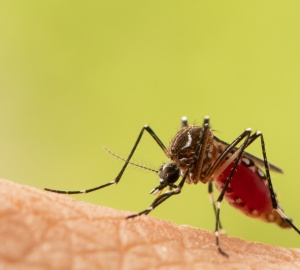
Understanding why certain individuals are more attractive to mosquitoes is crucial for malaria control, as the most bitten individuals are at the highest risk of infection and can disproportionately drive disease transmission in a population. One factor implicated in mosquito host preference is the human skin microbiome, which metabolises components of sweat and sebum into volatile organic compounds (VOCs) that can either attract or repel mosquitoes. Although individual VOCs and some bacterial species have previously been studied in isolation, few studies have comprehensively linked microbial composition, body odour profiles, and behavioural outcomes in mosquitoes.
In a study by Showering et al. (2022), researchers investigated how differences in the skin microbiome influence attractiveness to Anopheles coluzzii, a primary malaria vector. By integrating microbiome sequencing, volatile chemical analysis, and mosquito behaviour assays, the study aimed to identify microbial taxa and metabolic pathways associated with natural variation in human attractiveness to mosquitoes.
Study design and participants
To reduce variation due to age, sex, and hormonal influences, the study focused on 176 post-menopausal female twins, aged 50–90 years, recruited from the TwinsUK cohort. Volunteers were instructed to avoid skin products and odour-influencing foods, and were provided with odourless soap to standardise hygiene practices. Skin microbiome samples were collected via swabs from the soles of the feet, while body odour was collected overnight using nylon socks.
Behavioural assays were conducted in a dual-port olfactometer, in which mosquitoes were given a choice between the worn sock and a clean control. Attractiveness was quantified based on the proportion of mosquitoes attracted to the participant’s odour compared with an odourless control. Participants in the highest and lowest quintiles of attractiveness were selected for comparative analysis (n = 27 and n = 28, respectively).
Microbiome profiling and quality control
Skin swab samples underwent DNA extraction with additional lysis and elution steps to improve DNA yield from these inherently low-biomass samples. 16S rRNA gene sequencing of the V3/V4 region was performed using Illumina MiSeq™. To ensure data integrity, ZymoBIOMICS microbial community standards were included as positive controls during PCR and sequencing, alongside swab-only negative controls.
The inclusion of ZymoBIOMICS standards was critical for distinguishing true skin-derived taxa from contaminants introduced during sample handling or sequencing. These synthetic communities, with a defined composition of bacterial species, served as benchmarks for evaluating amplification efficiency, sequencing bias, and the sensitivity of the bioinformatics pipeline. This quality control approach provided confidence in the biological relevance of the results.
Microbial diversity and taxonomic differences
Alpha diversity was not significantly different between highly- and poorly-attractive groups. However, multivariate analysis revealed weakly significant differences in beta diversity, suggesting subtle but biologically relevant differences in microbiome composition between the groups.
Ten amplicon sequence variants (ASVs) were identified as differentially abundant. Notably:
- Three ASVs from the Staphylococcus 2 genus (Staphylococcaceae family) were over four times more abundant in highly-attractive individuals.
- ASVs from Corynebacterium and Finegoldia were more abundant in poorly-attractive individuals.
- Additional taxa, such as Sphingomonas, Brevundimonas, Limnohabitans, and Methylocaldum, were also differentially abundant and may influence odour profiles.
Microbial volatile organic compounds and odour chemistry
Gas chromatography was used to analyse VOCs collected from foot odour. Several of these compounds, including 1-octen-3-one, 1-octen-3-ol, and hexanoic acid, are known to influence Anopheles behaviour. Correlation analysis revealed significant associations between the abundance of specific bacterial genera and these odour compounds.
For instance, Corynebacterium abundance correlated with higher hexanoic acid levels, which has been reported as a potential repellent at low concentrations. Methylocaldum and Limnohabitans were linked to the production of 1-octen-3-one and 1-octen-3-ol, both attractants for Anopheles.
These findings suggest that differences in odour profiles between individuals may be driven in part by the specific microbial taxa present on the skin and their metabolic by-products.
Metabolic pathways and repellence
To explore functional potential, PICRUSt2 was used to predict bacterial metabolic pathways based on 16S rRNA data. Two propanoate-producing pathways, derived from L-glutamate and L-valine, were enriched in the poorly-attractive group, though differences did not reach statistical significance. The enrichment of these pathways in poorly-attractive individuals may suggest that they contribute to the production of VOCs with repellent properties or disrupt attractive blends.
Implications and applications
This study reinforces the link between human skin microbiota and mosquito host-seeking behaviour. By identifying specific bacteria and metabolic functions associated with lower attractiveness, the findings open new possibilities for developing microbiome-informed vector control strategies. These may include:
- Enhancing odour-baited trap design with microbial VOC blends
- Developing diagnostics to identify individuals at high risk of mosquito bites for targeted interventions
Limitations and future directions
While the study benefitted from a carefully controlled participant cohort, its findings are limited to post-menopausal women of European descent, and the low biomass nature of skin samples posed contamination challenges. Functional validation of candidate VOCs and microbial interactions using culture-based assays or shotgun metagenomics will be necessary to confirm causality.
Conclusion
Showering et al. provide compelling evidence that the skin microbiome mediates differential attractiveness to Anopheles mosquitoes through the production of VOCs. By integrating microbial ecology, chemical analysis, and behavioural testing, the study lays a foundation for microbiome-based approaches to mosquito bite prevention and malaria control.
References
Showering, A., Martinez, J., Benavente, E.D. et al. Skin microbiome alters attractiveness to Anopheles mosquitoes. BMC Microbiol 22, 98 (2022). https://doi.org/10.1186/s12866-022-02502-4
MiSeq is a registered trademark of Illumina Inc..
